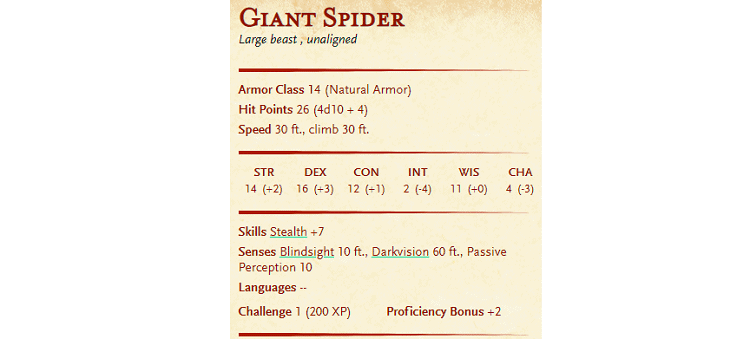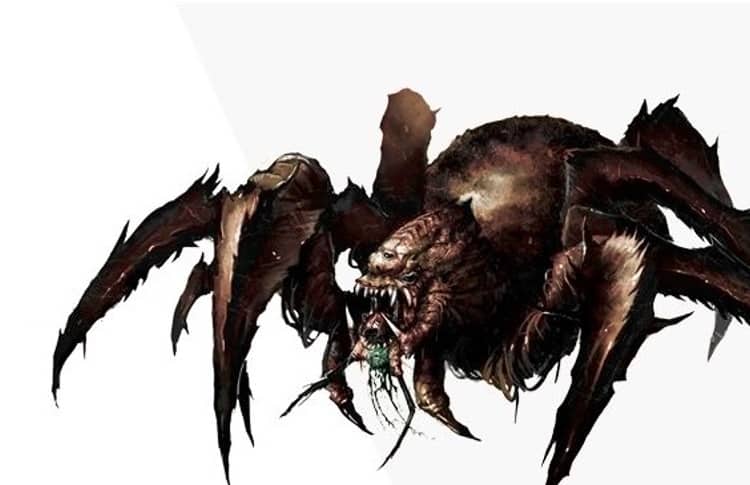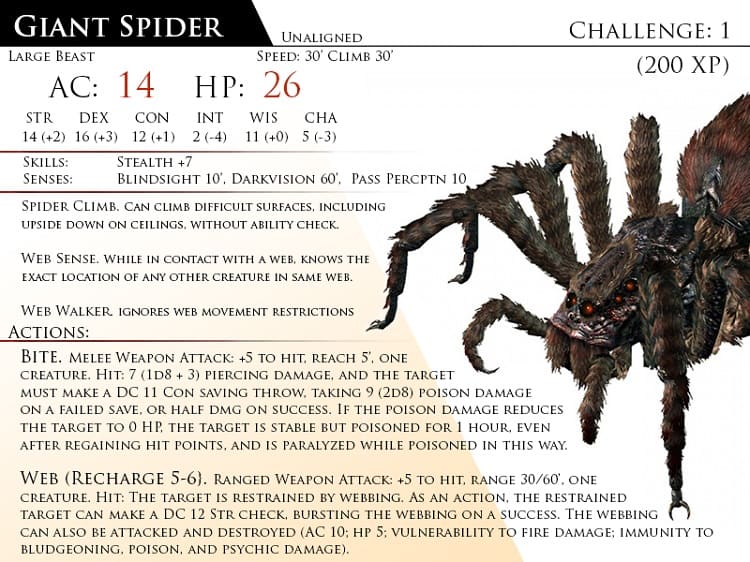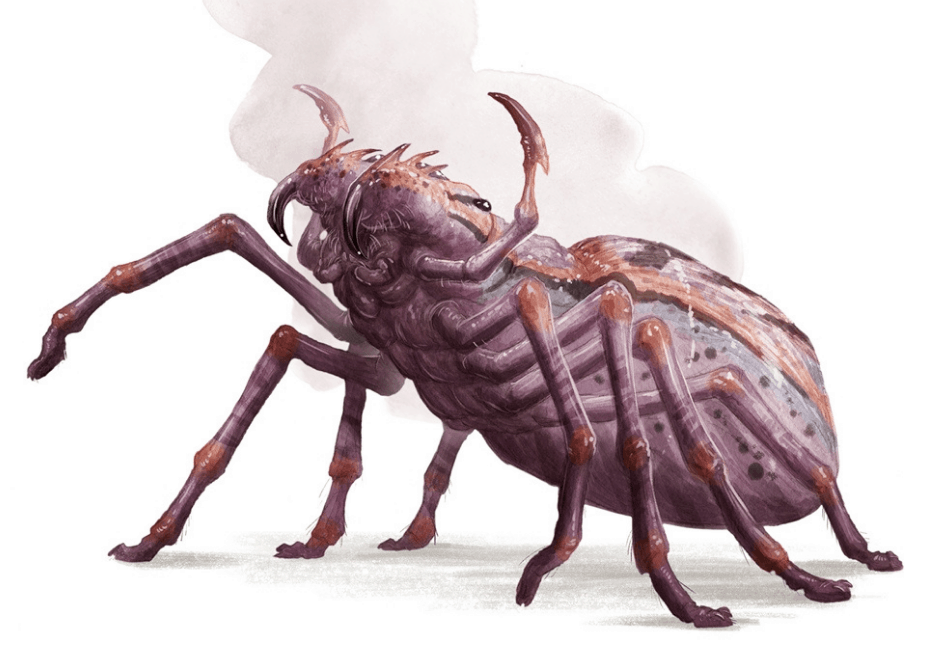Your party is walking through the woodlands, following a path. Your scout hears some sounds from the trees above you and your warrior steps in something white and sticky.
Is that webbing? Before any of you can move, the giant spiders descend and initiative is rolled! Giant spiders are a pretty common foe in the woodlands and jungles of countless worlds, not just the world of Faerun.
Although you might think that a ‘bigger than regular spider’ is a pretty easy monster to deal with, but there’s a lot of different aspects to a giant spider that can make it interesting and something your party will never forget.
What is a Giant Spider?

Giant Spiders are different sizes, because the word giant is pretty subjective. You can find ‘giant’ spiders the size of a dog or the size of a house, and nearly every real world spider tends to have a giant equivalent.
In terms of the game, they occupy a 10 foot by 10 foot square, making them twice as big as a human.
Here are the relevant stats for a giant spider:
Spider Climb: The Spider can climb difficult surfaces, including upside down on ceilings, without needing to make an ability check.
Web Sense: While in contact with the web, the Spider knows the exact Location of any other creature in contact with the same web.
Web Walker: The Spider ignores Movement restrictions caused by webbing.
They also have a poisonous bite and a rechargeable web attack, and they often attack in groups of three or four.
They also have a lot of points in stealth, strength, toughness, and dexterity, so they are pretty well rounded creatures. Finally, their AC is 14, so most adventurers will be able to hit them whenever the battle starts.
How Giant Spiders Work
The main three abilities for a giant spider are spider climb, web sense, and web walker, and they can use these to get around and ambush their prey.
Spiders can move anywhere in sleath, and as long as their prey doesn’t mean they are there, they can ambush from below, on walls, or up high.
Web sense allows the spiders to keep any prey who have gotten near the webbing. If a fighter or barbarian blunders into the web, or a curious druid or wizard touches it, then the spider in contact with the webbing will know that someone is messing with their web and will move to investigate.
Finally, webbing does slow down regular creatures, sticking and entrapping them, but spiders can use web walker to move through their webbing freely, pouncing on their prey before they have time to react.
The two main battle tactics for any type of spider include Bite and Web. Bite does a moderate amount of damage, but the real danger comes from the poison.
Any bitten target needs to make a DC constitution saving throw, taking 2d8 poison damage on a failed save and half damage on a success. This can be a max of 16 damage if you fail the save, which can be a large chunk of life for low level characters.
Now, if you happen to drop to zero hit points because of the bite, then you do not die but you are poisoned and paralyzed.
Even if you regain hit points you are still paralyzed and poisoned until the hour passes, so even if you win the battle, you might still be stuck for a while!
The second attack that spiders use is with their webbing. It’s a rechargeable attack that goes after 5 or 6 is rolled, and the spider can fire out a glob of webbing.
If the target is hit, then they are restrained by webbing. The webbing can be burst out of with a 12 or higher on a strength check, or others can attack the webbing and cut the character out.
How do Spiders Fight?

If the party encounters giant spiders, it bears a bit to know how they fight. Going with normal spiders and nothing homebrew, most spiders are ambushers and hunters.
In real life, spiders aim to catch a prey in their web, bite them and inject them with paralyzing poison, and then bind them up in webbing to feed on later.
Giant spiders are going to act the same way. They aren’t going to do battle with an adventuring group, they aren’t going to wait and ambush someone and then paralyze them to eat later.
So a typical spider is going to wait until someone has gotten tangled up in its web or is actively touching the web before striking.
They want their targets paralyzed and easy to eat, rather than engaging in battle. They’ll likely go after the squishy wizards and bards first, rather than the heavily armed and armored warriors.
Spiders will attempt to investigate the connection to their web and then snare their prey in webbing before paralyzing it with a bite.
Having the target restrained in webbing causes the bite to have advantage, so it’s in the spider’s interest to the web up a spider first.
However, always remember that the spiders are not fighting the adventures out of malice or anger, but instead because of food. If their prey puts up too much of a fight, then the spider will flee to fight another day rather than being killed for no good reason.
Read also: Comprehensive Snare 5e Guide.
How to Fight Spiders

Now that you know the spider’s tactics, here’s how to effectively counter them. If someone gets webbed and restrained, make sure your melee fighters get in close to them to either cut the character free or battle against the spider when it comes in close to attack the restrained target.
Ranged fighters and spellcasters will need to try and hit the spider with everything they have, and AoE attacks can be a great way to clear webbing from the battlefield.
Spellcasters and ranged fighters can also use attacks and abilities to keep the spiders contained and prevent them from moving, making sure that they can’t advance to attack any webbed up fighters.
Running from a spider controlled forest is also another option, because of the end of the day, spiders are hunters and not killers.
If your party puts up a good fight against them and they don’t manage to web or paralyze anyone, then if the party leaves the spiders may leave too. There’s no food for them, so why fight?
Making Spiders Interesting
That’s the basics of spiders, but if you want to make spiders interesting you can look to the real world to add to their tactics. For example, wolf spiders use trapdoors to ambush their prey.
They hide under rocks, debris, or dirt and wait for prey to pass by. Maybe the adventurers find themselves walking through a forest and suddenly giant wolf spiders spring out from the ground and start biting away at the nearest targets.
If the biting succeeds, then you’ve got two or three of the party poisoned and paralyzed and the rest surrounded by spiders.
Other types of spiders include Mammoth Spiders, who are much larger than even the biggest giant spiders, and can multiattack with a bite and with their massive claws.
Additionally, they can fire their webbing more often. If your party falls under the shadow of a mammoth spider, then they will be in for a tough fight.
Finally, phase spiders from not fire webs, but instead can shift from the material plane to the etheral plane or vice versa with bonus actions. They can teleport around the battlefield, flashing out with bites. It can certainly make them hard to hit!
Using Swarms
Giant spiders are often never alone in the forests, and to add some spice to an encounter you can have swarms of smaller spiders roaming around.
Swarms are much harder to hit and can cause a lot of damage if left unchecked, so if you find that the giant spiders are going down too easily, you can throw some swarms into the fight to represent the spider’s smaller brethren.
Who Uses Giant Spiders?

Typically, if you aren’t finding the giant spiders in the wild, you will most likely find them in the Underdark among the drow or used as mounts by goblins.
The drow worship giant spiders as Loth, their spider queen is said to always have giant spiders Serving her. The drow use these spiders as mounts to get around the Underdark and also as steeds to pull carts.
Goblins use them in the same way, often riding giant spiders into battle and using them to take prisoners during their raids. So, if you find yourself clashing with these factions you are more than likely battling against giant spiders too.
On the player’s side, a druid can use Wild shape to turn into a spider fairly early, as it is a climbing creature. They will have access to all of the character’s abilities, including the ability to climb on walls and create webs.
It’s a pretty interesting way to use both in and out of combat. In combat, a druid can web and paralyze enemies as a form of crowd control. Outside of combat, the druid can use the skills to climb on walls and reach new places.
Giant Spider FAQ’s
Question: How do I Homebrew a Giant Spider?
Answer: If you are a DM, there are dozens of ways to homebrew a giant spider to make them fit your theme. For example, you can give your spiders elemental damage if they are in a certain environment.
Ice spiders can do frost damage with their bites, perhaps freezing their targets when they are paralyzed rather than poisoning them.
Rock spiders could use their stealth to camouflage themselves as statues and instead of shooting webs they could have the skill ‘Earth Sense’ which allows them to sense the number and direction of anyone else touching the ground.
Rock spiders might count on their durability to make up for not shooting webs, instead using their claws to batter foes around before they bite down with rock hard jaws.
You can do this for every single type of spider. Just take a look at where they live and consider what adaptations they would have used to catch their food.
It’s not difficult to change some abilities and damage rolls around, or even to use the giant spider template to make new creatures that act like spiders.
Question: How many Giant Spiders are in a Group?
Answer: While most people think about spiders being solitary hunters and warriors, there are some spiders que are very communal. They work together, hunt much larger food together, and spin massive webs that hold over 50,000 spiders.
While you might not pit the party against that many giant spiders, it might be interesting to walk into a forest that has been taken over by a massive horde of spiders.
Swarms, regular spiders, and giant spiders can all live together as part of a community inside an overgrown forest or jungle.
That can certainly be a scary environment to be in for any arachnophobes in the group, especially since just about everything is covered in webbing… and we all know about the spider’s web sense!
Additionally, you can treat spiders as a hive minded race, and perhaps they are intelligent. That’s certainly an adventurer hook that will carry a campaign! Which does lead to the next question.
Question: Are Giant Spiders Intelligent?
Answer: In terms of stats, no, a giant spider has the base intelligence of 2 and a minus 4 to all intelligence checks. On their own they are completely focused on hunting and eating their prey.
However, some wizards and necromancers have been known to control giant spiders to act as guards and deterrents so petty adventurers don’t get too far into their lands.
Still, you can always homebrew a giant spider to be more intelligent than its regular brethren. But without that it is just a large beast that is subject to the rules that other large beasts are.
- DnD Demons Guide: What Are Demons in 5e? - September 18, 2021
- Detect Thoughts 5e Guide: When, Why and How to Use It - September 9, 2021
- The Ultimate DnD Toll the Dead 5e Guide - September 9, 2021

